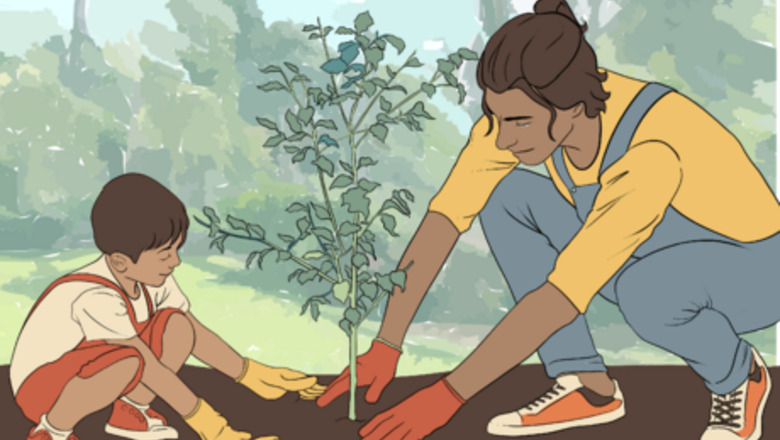
views
- Follow the 3 Rs: reduce, reuse, and recycle! Upcycle things you don’t need in fun creative projects, shop secondhand, and compost scraps too.
- Eat locally-grown foods, cut back on meat and dairy, and shop at farmer’s markets. Make an effort to conserve water and electricity around the house.
- Walk or bike rather than drive a car when possible. Volunteer your time to clean up the community and advocate for environmental awareness.
Plant a tree in your yard.
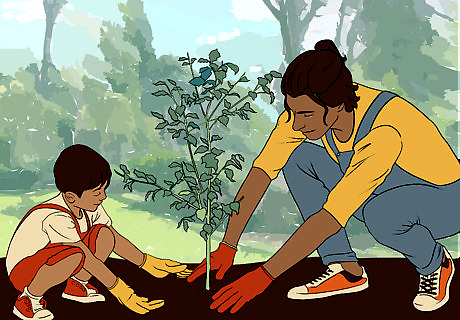
Trees save energy and release oxygen that keeps the air clean. If you have the means (and the yard space), plant a few trees on your property. Look for a variety that’s native to your area and help it grow by following the care instructions for that type of tree. Trees are crucial and also they provide over 70% of the world's oxygen to the environment, and they reduce the effects of global warming and climate change. You can also plant other plants in your yard that are native to your area in order to support local ecosystems and wildlife. If you don’t have a yard of your own, you could always support organizations that aim to plant more trees, like the Nature Conservancy’s Plant a Billion Trees campaign, or One Tree Planted.
Cut back on driving.

Find alternate forms of transportation that consume less (or no) gasoline. Walk or ride a bike whenever possible; they won’t cause any pollution or consume natural resources. If that isn’t an option, consider organizing carpools or using public transportation. Replacing car trips with public transport reduces road congestion and the overall amount of gasoline you use, cutting back your carbon footprint. Combine multiple errands into one trip to minimize the distance traveled and fuel consumed. If you need to use a car, choose fuel-efficient models or hybrid/electric vehicles. Regularly maintain your vehicle to ensure optimal fuel efficiency. Carpooling will also enable you to take a highway's High Occupancy Vehicle (HOV) lane, usually saving time and money on gasoline. Many bus systems in major cities operate diesel-electric hybrid buses, reducing harmful emissions.
Volunteer to clean up your community.

Volunteer work has a direct positive impact on your area’s environment. You can volunteer to pick up litter, plant community gardens, or clean up rivers. Find an activity that suits your interests and set aside time to help regularly! Plus, consider joining an environmental organization like Greenpeace, the Sierra Club, or the Environmental Defense Fund. If you prefer to be part of a group, volunteer with friends, your class, a church group, or anyone else.
Recycle items properly.
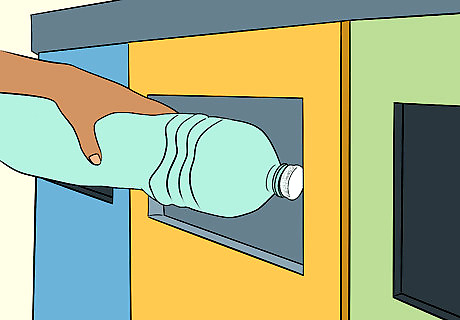
Recycling lowers the amount of environmental waste you produce. Aim to recycle clothes, glass, metal, plastic, and paper as often as possible. If your area offers curbside recycling, use it. If your area doesn’t offer curbside service, or if you have items not accepted for the regular service, take a trip to a recycling center near you. Check the rules and regulations in your area to ensure you recycle properly. For instance, some places may not accept glass, while others might require you to separate the different materials. It’s important to know what is and is not recyclable in your area because if you dispose of something improperly, the whole load will likely be rejected and end up in a landfill.
Upcycle items.

Creatively repurpose unwanted items to put less trash into the world. Instead of throwing things away, give them another purpose by making jewelry, household accessories, or restyled clothing. Upcycling is fun and good for the earth; for example, you could turn an old T-shirt into a grocery bag or use cinder blocks to make outdoor planters. Experiment and look for new ways to reuse old items. You might turn glass jars into windchimes or create lanterns with them. You could turn an old metal dish rack into hanging wall storage or use old newspapers to line a garden path before covering it with pebbles. Upcycling can be as simple as refinishing or repainting a piece of furniture rather than replacing it outright! If you aren’t going to reuse something yourself, donate it. This ensures that nothing is wasted, and someone in need can use your old items.
Compost your food scraps and yard waste.

Composting keeps trash out of the waste stream and creates rich soil. Create a compost pile outdoors, or use a bin to gather scraps if you need to compost indoors. Store all your biodegradable food scraps, paper, and plant matter in the compost and let it rot naturally. Once rotted, feel free to mix the compost with your soil for added nutrients. Food scraps that can go in the compost pile include fruits and veggies, egg shells, coffee grounds, nut shells, and tea bags. You can compost plant matter like yard trimmings, grass clippings, leaves, houseplants, sawdust, and wood chips. Other biodegradable materials include shredded newspapers, cardboard, hair and fur, and even fireplace ashes. If you don’t plan to use your compost, check and see if garbage removal services in your area can pick up organic waste as well as trash and recycling.
Cut back on product consumption.

When you buy less, you also stop more trash from piling up in landfills. Before making a purchase, ask yourself if you truly need it and how your purchase may impact the environment. This can be as simple as staying away from the clearance rack at a store so you don’t buy something you don’t really need, or buying an entire jar of peanut butter rather than an individual serving. Avoid purchasing products with excess packaging. Often, food companies spend just as much energy creating the packaging for food products as they do producing the actual food. When you do buy something, look for durable products that will last you a long time. Borrow or rent items you need only for brief or occasional use.
Shop at second-hand stores.

Save energy and natural resources by buying secondhand clothes. Visit thrift stores and vintage shops to buy clothing and look for other gently used goods like toys, games, furniture, and appliances. You might be surprised by what you can find at a secondhand shop! Producing new goods consumes energy and produces packaging that fills up the trash, which you can avoid by shopping secondhand. This philosophy also applies to bigger purchases, like cars. Buying a secondhand car can help the environment and impacts your wallet less. If you have family members or friends looking to give away some clothing, consider doing a swap with them. You can refresh your wardrobe without buying anything at all. EXPERT TIP Alena Le Blanc Alena Le Blanc Personal Stylist Alena Le Blanc is the Personal Stylist and the Founder of Le Blanc Label. Based in San Francisco, California, Le Blanc Label is the leading personal stylist brand for sustainable style transformations. Alena and her team specialize in seasonal wardrobe refreshes, closet edits, styling for special events, travel, photoshoots, and general personal needs. Alena has been featured in podcasts including EMPOWERED BY WMN, I Am Fearless, and Mind Power Meets Mystic. Alena received her BFA in Fashion and Apparel Design from the Academy of Art University. Alena Le Blanc Alena Le Blanc Personal Stylist Invest in well-made garments that are eco-friendly. Look for natural, sustainable fabrics like organic cotton or recycled synthetics. Look for durable denim with a high cotton content (around 98-99%). Prioritize quality over quantity to extend your closet's lifespan and reduce your environmental footprint.
Choose reusable items over single-use plastic.

Plastic items often end up polluting the environment and hurting wildlife. Opt to use reusable shopping bags instead of store-provided plastic ones and regular cups, plates, and utensils instead of paper and plastic. Fill up a reusable water bottle and refuse to buy plastic ones. You might have a little more cleanup at the end of the day, but it’s less harmful to the environment and will save you money. Next time you need batteries, consider investing in rechargeable ones. Most batteries can now be thrown out with the regular trash—thanks to reduced chemical use—but they still take up space in landfills.
Reduce the amount of paper you print and use.

Paper production emits greenhouse gasses that harm the environment. Look for paper products made of 80-100% recycled paper, and use only as much toilet paper, napkins, and paper towels as you need to get the job done. Avoid printing out paper whenever possible, too. Before printing, consider whether emailing a document or creating a digital file would work just as well. Try using a washable cloth or sponge for most of your cleanup if possible.
Buy locally-sourced foods.

Eating fresh, local food consumes less fuel and packaging materials. Shipping products by truck, rail, flight, or boat creates pollution and takes a toll on the environment. Instead, shop at local farmer’s markets and grocery stores that stock locally-sourced products. Alternatively, use a CSA (community-supported agriculture) service to get fresh produce regularly. If you’re in the US, look for CSAs using the Department of Agriculture’s directory. Otherwise, do an online search for CSA produce boxes. Local foods are fresher, so they’re higher in nutrient value! Avoid waste by planning your meals ahead of time so you don’t cook more than you’ll eat. Store leftovers and use them for one of your meals over the next few days. Buy from local artisans, clothing makers, and retailers too. Avoid ordering things online to be shipped to you whenever possible. The more locally-sourced products you buy, the better.
Cut back on eating meat and dairy.

Avoiding meat and dairy will also lessen your environmental impact. Cultivating and processing meat and dairy on farms consumes water, energy, and food, ultimately emitting greenhouse gasses into the environment. Plus, agricultural expansion contributes to deforestation. Consider eating less meat and moving towards a plant-based diet with lots of vegetables and legumes, which create much less pollution. You don’t have to go fully vegetarian or vegan, especially if you have dietary restrictions that would make it difficult. The most important thing is to cut back on meat and dairy as much as your dietary needs allow. Meat and dairy are also typically more expensive, so cutting back and eating vegetarian meals can help your wallet! Eat more seafood as well. Seafood (and seafood fishing) is much more sustainable than producing vast amounts of meat and dairy, and it’s a great source of protein in your diet.
Conserve water around the house.
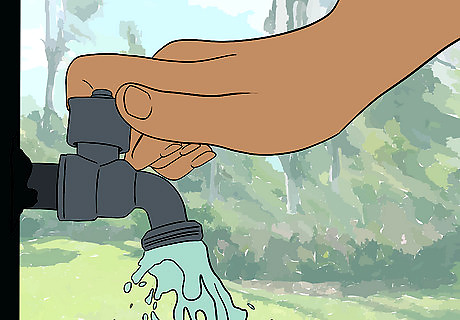
Reducing your water use saves energy and helps the ecosystem. Take short, 5-minute showers, turn off the faucet while brushing your teeth, and only run dishwashers and washing machines when you can completely fill them up. Plus, try collecting rainwater and use that to water your plants, rather than using a hose or sprinkler all the time. The less you use, the less wastewater ends up in the ocean! Consider investing in a high-efficiency washing machine in the future. Fix leaky faucets and pipes as soon as possible to avoid wasting water. Install efficient shower heads and low-flow faucets in your kitchen and bathrooms to reduce water consumption further. Use a pool cover if you have an outdoor swimming pool. This will prevent water from evaporating, so you don’t need to refill the pool as often.
Use fewer chemicals in your daily life.
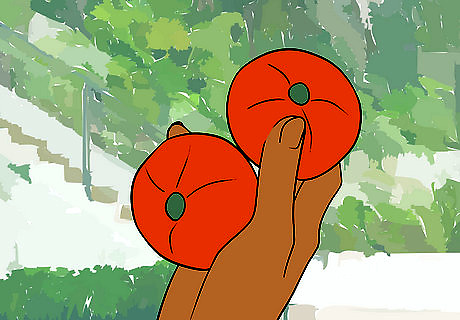
Some chemicals have harmful long-term effects on the environment. Choose chemical-free lawn-care products, plus all-natural household cleaners, beauty, and hygiene products. The fewer chemicals you use on a daily basis, the healthier the environment will become. Plus, natural and chemical-free products are also good for you! When you have hazardous materials to throw away—like fluorescent light bulbs, cleaning products, pharmaceuticals, pesticides, automotive fluids, and paint—be sure you dispose of it properly. Harmful chemicals and materials should never end up in a landfill, sanitary sewer, or storm drain! Contact your local waste management office for proper disposal options. Avoid blowing up helium balloons, too. Fill them up with regular air instead.
Conserve electricity at home.

Saving electricity is critical to reducing air and water pollution. Make a habit of conserving electricity by turning off lights and appliances when you’re not using them! Fully unplug electronics that aren’t in use—or use smart power strips that automatically turn off for you. Using energy-efficient and long-lasting LED lightbulbs can also reduce greenhouse gas emissions at home. When you buy new appliances, be sure to choose Energy Star-certified products. Air-dry your clothes on a clothesline rather than turning on a dryer. Cut back on your heating and air conditioning use by ensuring your home is properly insulated and sealing air leaks around doors and windows. If nothing else, you can always throw on a sweater when it’s cold or turn on a fan when it’s hot, rather than using energy-consuming air conditioning or heating.
Donate to environmental causes.

Your support can help organizations that are trying to save the planet. If you have extra money to give, consider donating funds to an environmental cause. Choose a charitable organization that appeals to your interests and values, and donate when you can. Encourage other friends and family to support environmental organizations too! For example, you could host a Facebook fundraiser on your birthday and ask people to donate to an organization you support. Check out organizations working to save the environment like the Rainforest Alliance, Earthjustice, the Ocean Conservancy, or the World Wildlife Fund.
Encourage others to help save the environment.
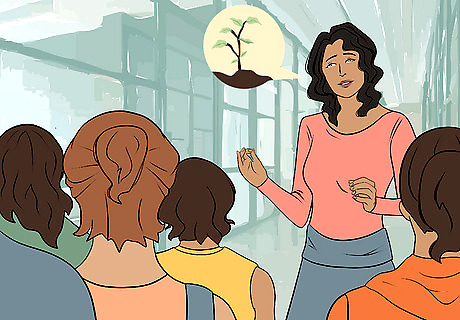
Advocacy and education allow more people to create a positive impact. Spread the word about environmental conservation by sharing information on social media and in conversations with your family and friends, by sharing about some of the lifestyle changes you've made, and by encouraging others to take action as well. Get involved politically by contacting government officials about supporting renewable energy and voting for people who prioritize environmental conservation. Visit https://www.usa.gov/elected-officials to find local representatives in the United States. If a friend or family member asks for tips, be sure to educate them about what they can do to save the environment and encourage them to get involved, too!


















Comments
0 comment